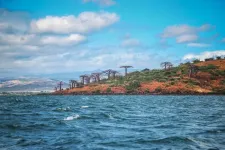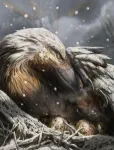(Press-News.org) Payment for Ecosystem Services programs (PES) are important tools that governments around the world use to improve water quality, protect forests and wildlife habitat, and sequester carbon. Under these programs, landowners - usually farmers - are paid to use their land in ways that protect or restore the environment, such as replacing row crops with trees or grassy zones adjacent to waterways. Many PES program contracts last 5 to 20 years, but participant drop out rates have consistently risen over the years.
A recent study by University of Maryland economists showed that PES programs are currently structured in ways that could limit their participation or create incentives to leave the programs early, before the full environmental benefits are realized. The new study identifies a key flaw in the way penalties are assessed for participants who withdraw early and suggests that addressing this flaw would increase program completion rates and result in both higher payments to farm owners and more ecosystem benefits.
The study was published on May 15, 2024, in the Journal of Environmental Economics and Management.
“The current programs are backward looking, so if a participant withdraws early from the contract, they must pay back all the money they received through the program,” said David Newburn, an associate professor of agricultural and resource economics at UMD and a co-author of the study. “But in economics, we know that if payments are directly tied to penalties, that’s restrictive, and it can’t be optimal. So, we said, let’s uncouple them and see what solution would happen.”
Newburn and his colleagues found that calculating penalties based on the environmental benefits lost by early withdrawal provided the optimal economics for both the participants and the government offering the program.
PES programs make payouts to land owners each year they participate. Which means every year, participants have to decide if the overall benefits of staying in the program exceed what they would expect to earn if the land were converted back to crops. With the current programs, the penalties for quitting early escalate each year along with the total amount of money they have received.
If at any time a farm owner believes they might not stay in the program through the end of the contract—because the price of crops rises and they risk losing out on a lot of profit, for example—it makes more fiscal sense to get out early rather than waiting another year or two, when the penalty will only increase.
“There are many studies looking at payment structures, and government agencies have increased payments to landowners to increase participation,” Newburn said. “But no other researchers have looked at the effect of penalties in these programs, and they turn out to be significant.”
To understand the impacts of uncoupling penalties from payments, the team modeled costs and benefits to the landowners of different program designs as well as the benefits from the ecosystem services gained. They found that the optimal program design charged an early withdrawal penalty tied to the value of ecosystem services and payments remaining in the program. So, if a farmer withdrew from a 10-year conservation contract in year 2, they would have to pay 8 years’ worth of lost future ecosystem services. If they withdrew in year 8, they would pay only 2 years’ worth of lost ecosystem services.
In this way, the penalty for leaving is greatest early in the program and decreases over time, unlike the current programs in which penalties increase over time as payments accumulate. This design would not only incentivize landowners to stay in the program, but it also returned the highest benefits in ecosystem services, which translates to the highest value to the government agency paying for the program.
Newburn and his colleagues modeled a PES program that pays farmers to convert cropland adjacent to streams into grass buffer zones. These grassy streamside areas absorb nutrients and sediment runoff that would otherwise pollute the local waterways and the Chesapeake Bay. In the Chesapeake Bay watershed, such programs are an essential tool that helps Bay states achieve the EPA-designated limits for sediment and nutrients flowing into the watershed.
The team used USDA data on the value of cropland within 100 feet of a stream throughout Maryland to determine the payment structure for their model programs. Then they used commonly accepted formulas from the EPA’s Chesapeake Bay Watershed Model and the Chesapeake Bay Program to estimate the dollar value of the ecosystem services of grass buffers in those same areas. (Broadly, those formulas calculate the amount of nitrogen phosphorus and sediment each acre of grassland would prevent from entering the adjacent stream or waterway, and then put a per-pound price tag on each of those pollutants.)
The result was a dollar figure for the ecosystem services each farm could provide if it was enrolled in a grassland buffer PES program. Newburn said their study could be applied to any PES program, in any country, as they all currently use the same flawed penalty structure.
“In every PES program we found in Costa Rica, the UK, South Korea, Mexico, Australia, the European Union and others, they all have this same flawed structure of tying penalties to payments,” he said. “It’s easier to track than ecosystem services, which is very complicated to calculate, and may be hard to implement in practice. But the important point is that rather than getting the benefits precisely estimated, the optimal program structure will be forward looking versus backward looking as they are now.”
In addition to Newburn, Professor Erik Lichtenberg and PhD candidate Youngho Kim are co-authors on the paper, TITLE, DATE, Journal of Environmental Economics and Management.
This research was supported by the United States Department of Agriculture McIntire Stennis Research Program and the Harry R. Hughes Center for Agroecology. The views expressed in this article do not necessarily reflect the views of these organizations.
END
Penalties for dropping out of ecosystem services incentive programs should equal lost environmental benefits
UMD researchers find that new forward-looking approach would encourage participation and completion of incentive programs while increasing effectiveness.
2024-05-15
ELSE PRESS RELEASES FROM THIS DATE:
Lithuanian researchers’ new development in solar cell technology – a promise of a significant advancement in the field
2024-05-15
Researchers from Kaunas University of Technology (KTU), Lithuania, who contributed to the development of record-breaking solar cells a few years ago, expanded their invention. The self-assembled monolayers can now be applied not only in inverted but also in regular structure perovskite solar cells.
Self-assembling molecules arrange themselves into a single-molecule-thick layer and in this case, they act as an electron-transporting layer in solar cells.
“The molecules that make up these monolayers, like a clever glue, ...
A simple internet with significant possibilities
2024-05-15
It’s one thing to dream up a quantum internet that could send hacker-proof information around the world via photons superimposed in different quantum states. It’s quite another to physically show it’s possible.
That’s exactly what Harvard physicists have done, using existing Boston-area telecommunication fiber, in a demonstration of the world’s longest fiber distance between two quantum memory nodes to date. Think of it as a simple, closed internet between point A and B, carrying a signal encoded not by classical ...
Unwrapping the origin story of the baobab
2024-05-15
The baobab (Adansonia) is a genus of trees with eight extant (in existence currently) species and a long history of humans marveling at them. For as much admiration the baobabs get, there is an equal amount of mystery surrounding their origin.
Genomic and ecological analyses recently done by a global research team led by Sino-Africa Joint Research Center, CAS (hosted by Wuhan Botanical Garden of the Chinese Academy of Sciences), suggest that Madagascar, is the origin from where all other baobab species hail. With a deeper understanding of the baobabs' genetics, researchers are hoping to uncover some clues on what ...
The origin and long-distance travels of upside down trees
2024-05-15
The iconic baobabs, also known as upside-down trees, or the tree of life, have much cultural significance, inspiring innumerable arts, folklore, and traditions. A research published in Nature, involving international collaboration between Wuhan Botanical Garden (China), Royal Botanic Gardens (Kew, UK), University of Antananarivo (Madagascar) and Queen Mary University of London (UK) reveal a remarkable example of species radiation in Madagascar followed by long distance dispersal to Africa and Australia. With speciation, an astonishing divergence of pollination mechanisms evolved, that exploit hawkmoths, bats and lemurs for ...
Some mice may owe their monogamy to a newly evolved type of cell
2024-05-15
NEW YORK, NY — What makes the oldfield mouse steadfastly monogamous throughout its life while its closest rodent relatives are promiscuous? The answer may be a previously unknown hormone-generating cell, according to a new study published online today in Nature from scientists at Columbia's Zuckerman Institute.
"The hormone from these cells was actually first discovered in humans many decades ago, but nobody really knew what it did," said Andrés Bendesky, MD, PhD, a principal investigator at Columbia's Zuckerman Institute. "We’ve discovered ...
Mortality in patients hospitalized for COVID-19 vs influenza in fall-winter 2023-2024
2024-05-15
About The Study: This study found that in fall-winter 2023-2024, the risk of death in patients hospitalized for COVID-19 was greater than the risk of death in patients hospitalized for seasonal influenza.
Corresponding Author: To contact the corresponding author, Ziyad Al-Aly, M.D., email ziyad.alaly@va.gov.
To access the embargoed study: Visit our For The Media website at this link https://media.jamanetwork.com/
(doi:10.1001/jama.2024.7395)
Editor’s Note: Please see the article for additional information, including other authors, author contributions and affiliations, conflict of interest and financial disclosures, and funding and support.
# # ...
First ‘warm-blooded’ dinosaurs may have emerged 180 million years ago
2024-05-15
The ability to regulate body temperature, a trait all mammals and birds have today, may have evolved among some dinosaurs early in the Jurassic period about 180 million years ago, suggests a new study led by UCL and University of Vigo researchers.
In the early 20th century, dinosaurs were considered slow-moving, “cold-blooded” animals like modern-day reptiles, relying on heat from the sun to regulate their temperature. Newer discoveries indicate some dinosaur types were likely capable of generating their own body heat but when this adaptation occurred is unknown.
The new study, published in the journal Current Biology, looked at ...
Next-generation sustainable electronics are doped with air
2024-05-15
Semiconductors are the foundation of all modern electronics. Now, researchers at Linköping University, Sweden, have developed a new method where organic semiconductors can become more conductive with the help of air as a dopant. The study, published in the journal Nature, is a significant step towards future cheap and sustainable organic semiconductors.
“We believe this method could significantly influence the way we dope organic semiconductors. All components are affordable, easily accessible, and potentially environmentally friendly, which is a prerequisite for future sustainable ...
Disparities in patient portal engagement among patients with hypertension treated in primary care
2024-05-15
About The Study: This cohort study of patients with hypertension found clear sociodemographic disparities in patient portal engagement among those treated in primary care. Without special efforts to engage patients with portals, interventions that use patient portals to target hypertension may exacerbate disparities.
Corresponding Author: To contact the corresponding author, Rasha Khatib, Ph.D., M.H.S., email rasha.alkhatib@aah.org.
To access the embargoed study: Visit our For The Media website at this link https://media.jamanetwork.com/
(doi:10.1001/jamanetworkopen.2024.11649)
Editor’s Note: Please see ...
Dose-dependent association between body mass index and mental health and changes over time
2024-05-15
About The Study: This study revealed a U-shaped association between adolescent body mass index and mental health, which was consistent across sex and grades and became stronger over time. These insights emphasize the need for targeted interventions addressing body image and mental health, and call for further research into underlying mechanisms.
Corresponding Author: To contact the corresponding author, Shanquan Chen, Ph.D., email Shanquan.chen@lshtm.ac.uk.
To access the embargoed study: Visit our For The Media website at this link https://media.jamanetwork.com/
(10.1001/jamapsychiatry.2024.0921)
Editor’s ...
LAST 30 PRESS RELEASES:
Why nail-biting, procrastination and other self-sabotaging behaviors are rooted in survival instincts
Regional variations in mechanical properties of porcine leptomeninges
Artificial empathy in therapy and healthcare: advancements in interpersonal interaction technologies
Why some brains switch gears more efficiently than others
UVA’s Jundong Li wins ICDM’S 2025 Tao Li Award for data mining, machine learning
UVA’s low-power, high-performance computer power player Mircea Stan earns National Academy of Inventors fellowship
Not playing by the rules: USU researcher explores filamentous algae dynamics in rivers
Do our body clocks influence our risk of dementia?
Anthropologists offer new evidence of bipedalism in long-debated fossil discovery
Safer receipt paper from wood
Dosage-sensitive genes suggest no whole-genome duplications in ancestral angiosperm
First ancient human herpesvirus genomes document their deep history with humans
Why Some Bacteria Survive Antibiotics and How to Stop Them - New study reveals that bacteria can survive antibiotic treatment through two fundamentally different “shutdown modes”
UCLA study links scar healing to dangerous placenta condition
CHANGE-seq-BE finds off-target changes in the genome from base editors
The Journal of Nuclear Medicine Ahead-of-Print Tip Sheet: January 2, 2026
Delayed or absent first dose of measles, mumps, and rubella vaccination
Trends in US preterm birth rates by household income and race and ethnicity
Study identifies potential biomarker linked to progression and brain inflammation in multiple sclerosis
Many mothers in Norway do not show up for postnatal check-ups
Researchers want to find out why quick clay is so unstable
Superradiant spins show teamwork at the quantum scale
Cleveland Clinic Research links tumor bacteria to immunotherapy resistance in head and neck cancer
First Editorial of 2026: Resisting AI slop
Joint ground- and space-based observations reveal Saturn-mass rogue planet
Inheritable genetic variant offers protection against blood cancer risk and progression
Pigs settled Pacific islands alongside early human voyagers
A Coral reef’s daily pulse reshapes microbes in surrounding waters
EAST Tokamak experiments exceed plasma density limit, offering new approach to fusion ignition
Groundbreaking discovery reveals Africa’s oldest cremation pyre and complex ritual practices
[Press-News.org] Penalties for dropping out of ecosystem services incentive programs should equal lost environmental benefitsUMD researchers find that new forward-looking approach would encourage participation and completion of incentive programs while increasing effectiveness.






